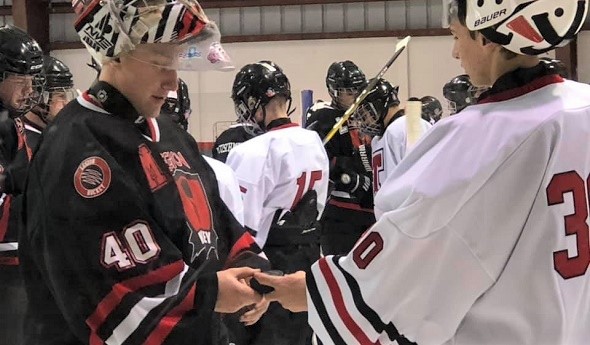
Thumb Schools Form Hockey 'Legion'
By
Paul Costanzo
Special for MHSAA.com
December 12, 2018
Larry Camp is happy to be focusing on hockey.
 The coach of the first-year Eastern Thumb Area Legion hockey program – also known simply as Ubly – had been working since February, navigating the politics of school boards and paperwork to create an opportunity for athletes in the Thumb to play high school hockey.
The coach of the first-year Eastern Thumb Area Legion hockey program – also known simply as Ubly – had been working since February, navigating the politics of school boards and paperwork to create an opportunity for athletes in the Thumb to play high school hockey.
“Come about October, all I kept telling my other assistant coaches was, ‘I just can’t wait to get on the ice,’” Camp said. “Everybody was like, ‘How’s your team? What’s it going to be like?’ I kept saying that I won’t know until our first game. When that first game came, it was a huge relief.”
Student-athletes from seven schools which make a 151-mile circle in Huron and Sanilac counties have come together to form the team, which is competing without a conference but in Division 2 for the MHSAA Tournament.
Sandusky, Elkton-Pigeon-Bay Port Laker, Bad Axe, Deckerville, Croswell-Lexington and Marlette join Ubly as schools providing players for the team. The Legion plays its home games out of Colleen J. Howe Arena in Sandusky and also holds practices at the Huron County Expo Center in Bad Axe to try and cut down on the constant travel some of its players would have to endure.
“I grabbed a map and looked at where we thought we could pull kids from – where would be the seven best school districts that we could fit,” Camp said. “What we looked at was where the two ice arenas are, and we tried to make a straight line up and down. When word got out, we had five or six other schools call us that wanted to get (involved). They really wanted to join, but we already had our seven.”
Twenty-seven players came to the first tryout, and Camp said he’s carrying a roster of 23. The numbers surprised him, but the desire to play high school hockey was high for kids who had spent time in the Huron and Sanilac county hockey associations.
“I was going to stop playing hockey this year because of the drive (to Bay City) – it was an hour and a half to practice,” Legion captain and Sandusky senior Jarod Coon said. “Now, it’s where I go to school. I love hockey, so it’s real nice to keep going.”
Coon, who plays center, has been playing hockey for more than a decade, joining teams in Port Huron, Mount Clemens and Bay City after starting his career in Sanilac County. His story isn’t uncommon on this team.
Marlette senior goaltender Chad Bower, also a captain, had been playing hockey since he was 5 years old and doing so without ever having the prospect of playing for his high school.
“I played travel my seventh and eighth grade year, then the next year my team dismantled,” he said. “Some of the boys went to (Saginaw) Heritage, Davison, stuff like that. That next year, I had to come back and play football. I was actually really excited (to play high school hockey), but then at the same time kind of mad, because it was already my senior year.”
 Collecting excited and experienced hockey players wasn’t an issue for Camp. But even after petitioning school boards, attending meetings and getting the approval from the MHSAA in July, he still had to create a schedule for his team – which can be difficult for an independent and a newcomer. Through some more hard work, he was able to get to a full 26 games.
Collecting excited and experienced hockey players wasn’t an issue for Camp. But even after petitioning school boards, attending meetings and getting the approval from the MHSAA in July, he still had to create a schedule for his team – which can be difficult for an independent and a newcomer. Through some more hard work, he was able to get to a full 26 games.
“I didn’t know any athletic directors, didn’t know their contact information,” he said. “I went to the MHSAA website and looked up names and numbers. The coach from Port Huron Northern (Daryel McCarrel) helped me a lot. The guys from the Imlay City team, the Alliance, those guys gave me a lot of contact info. I must have sent 150 emails, and I could barely get my number of games.”
The schedule mostly features teams from the region, such as Lapeer, Bay City and Port Huron. But there was a trip to Dearborn already, and Mount Pleasant will make its way to Sandusky later in the season. The Legion also played a pair of games against Tawas, the state’s other new hockey program this season. Tawas won the first meeting, 3-2, and the teams played to a scoreless tie in their second meeting.
“That was pretty cool with it being our first season and their first season,” Bower said. “We did like a first-year gift exchange, stuff like that. It was really cool to be a part of that.”
The Legion has started 2-3-1, and players are working not only to get used to coach Camp’s systems and the pace of the high school game, but also to each other.
“We just try to be friendly to each other, pretty much,” Coon said. “We haven’t done too much outside of practice, but we’re looking at going to the playoffs with the college teams at Little Caesars (Arena), just for some team bonding. I kind of thought it would be (weird playing with kids from rival schools), but it’s not really. Some of the people, I either don’t know them from other sports, or they’re just really good guys, and I like them anyways.”
When it comes to setting goals for the season, players are keeping things realistic. Bower said that while a deep run in the Division 2 playoffs would be great, he’s first focusing on the team finishing above .500.
Of course, as the first year of the program, it’s also about much more than this year.
“I’m interested to see what it turns into if it keeps going, which I really hope it will,” Coon said. “To see what it turns into in 15 years, then I can come back and say, ‘I was the first captain on that team.’ Right now, we’re looking to set up a good name for ourselves, so a lot of kids that didn’t try out this year or maybe didn’t know about the team will know about it and are excited to try out for next year. I guess we’re just trying to get a good reputation. And win some games.”
 Paul Costanzo served as a sportswriter at The Port Huron Times Herald from 2006-15, including three years as lead sportswriter, and prior to that as sports editor at the Hillsdale Daily News from 2005-06. He can be reached at [email protected] with story ideas for Genesee, Lapeer, St. Clair, Sanilac, Huron, Tuscola, Saginaw, Bay, Arenac, Midland and Gladwin counties.
Paul Costanzo served as a sportswriter at The Port Huron Times Herald from 2006-15, including three years as lead sportswriter, and prior to that as sports editor at the Hillsdale Daily News from 2005-06. He can be reached at [email protected] with story ideas for Genesee, Lapeer, St. Clair, Sanilac, Huron, Tuscola, Saginaw, Bay, Arenac, Midland and Gladwin counties.
PHOTOS: (Top) Legion goalie Chad Bower, left, meets with this counterpart from Tawas during their first of two games against each other this season. (Middle) An Eastern Thumb Area player launches a shot against Port Huron. (Photos courtesy of the Eastern Thumb Area hockey program.)
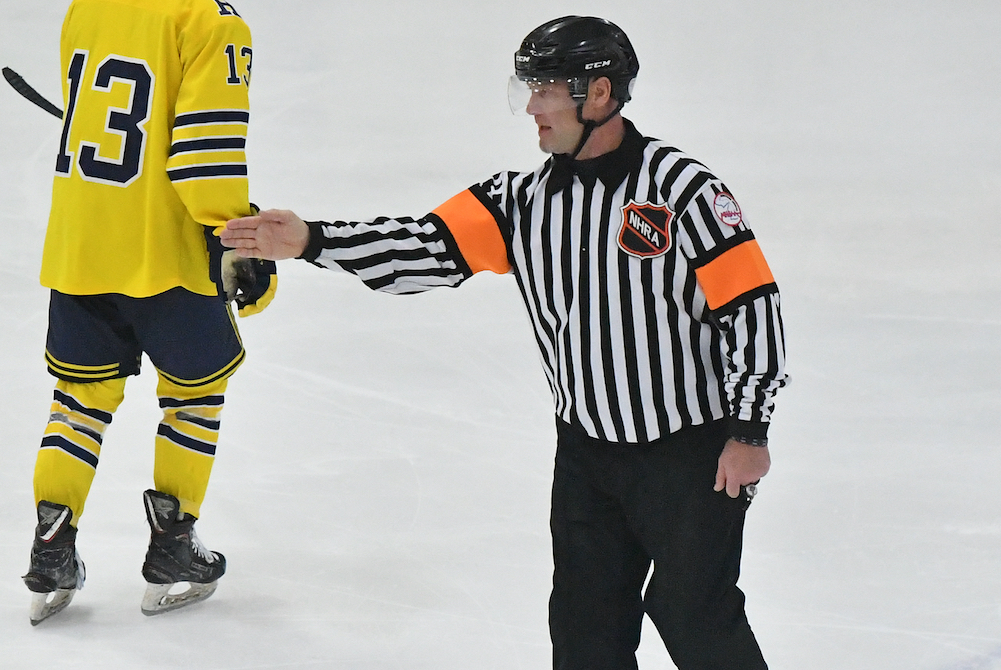
Retired NHL-er Back on Ice to Answer Call - By Making Them
By
Rob Kaminski
MHSAA benchmarks editor
March 16, 2023
The most accomplished skater on the ice during Friday’s triple-overtime MHSAA Division 1 Semifinal hockey thriller between Hartland and Brighton was not wearing the school colors of either team.
In front of a packed house at Plymouth’s USA Hockey Arena, referee Bryan Smolinski was in stripes, just like the rest of his officiating crew.
In his former life, he pulled on plenty of sweaters before lacing up the skates. That happens when one logs more than 1,000 games, tallies nearly 300 goals (274) and close to 400 assists (377) with eight teams spanning a 15-year playing career in the National Hockey League.
So, how did the 52-year-old former star player find himself on the ice last weekend as one of the referees for the pinnacle weekend of this high school season? Good question, even for the man known as “Smoke” during his playing days.
“I was working in youth development programs a few years back and reached out to some Michigan guys I had connections with about other ways to help the game,” Smolinski said. “I called Kevin May just to chat and asked, ‘Hey, how’s your reffing going?’ He said, ‘You know, we’re down a little bit,’ then said, ‘Why don’t you do it?’ I said, ‘Not a chance,’” Smolinski laughed.
Never Say Never
May persisted, imploring his friend to skate with him during a Fall league at Cranbrook in Bloomfield Hills. After eight weeks, once a week, Smolinski had a revelation.
“I’m like, ‘I’m kind of diggin’ this,’” Smolinski said “So, I did all the testing, and the educational part of it, and I really enjoyed it. I got with Danny (DiCristofaro) and his group, and he put me in as much as he could, and I really started to get my feet wet.”
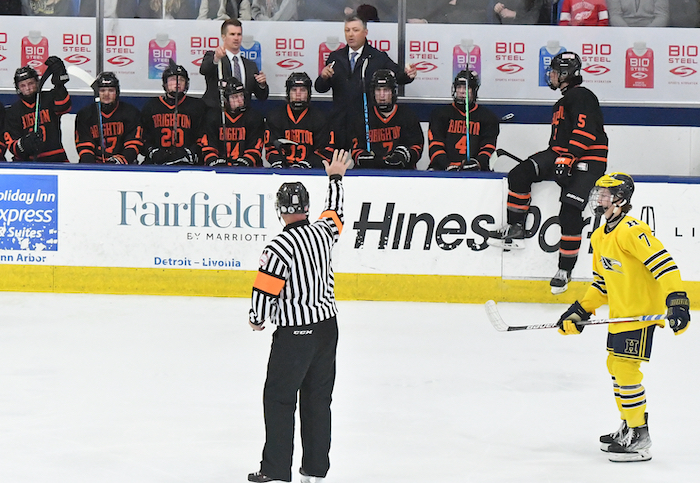 DiCristofaro is the assigner and referee-in-chief for the MHSAA’s Northeast Hockey Referees Association, and he has seen Smolinski’s growth first-hand.
DiCristofaro is the assigner and referee-in-chief for the MHSAA’s Northeast Hockey Referees Association, and he has seen Smolinski’s growth first-hand.
“Obviously he’s got great instincts and a feel for the game, along with a wealth of experience, all of which has allowed him to climb the ladder quickly,” said DiCristofaro. “It’s been a joy to watch his growth as an official.”
Fast forward to last Friday, and there were Smolinski and May sharing duties as referees during the MHSAA Semifinal with linesmen Michael Andrews and Thomas Robbins.
In between, there has been a learning curve that still continues, but the jump to officiating was not quite as daunting as his introduction to the NHL.
“I was scared to death. My first game was against Mario Lemieux. I’m in the old Boston Garden and now I’m playing against these guys and it’s their job, and they’re out there trying to make a living,” Smolinski recalled.
The emotions were not running nearly as frenzied for his first game as an MHSAA official, obviously, yet respect came in a different form.
“I couldn’t pick the puck up, I was breathing heavily; it was Kevin and me doing a two-man game in Brighton,” Smolinski recalled. “There were a few high-end kids playing, and I’m thinking, ‘I’m dying here.’ You know, there’s no training for that first time.”
What that experience did, however, was revitalize Smolinski in a new way. His playing career is well documented, not only in the NHL, but around Michigan. He enjoyed an honor-laden career at Michigan State University from 1989-93 before joining the Boston Bruins (who had drafted him three years earlier) at the end of the ’93 NHL campaign. Even after his final season, with Montreal in 2007-08, he stayed in the game via men’s leagues, or coaching his son, Max.
Smolinski and his wife, Julie, have three daughters: Ashtyn (22), Jojo (16) and Rylen (12), along with Max, whom dad coached for seven years including during a national championship run with a Little Caesars U15 team in 2019. Max, 19, is now playing collegiately at Rensselaer Polytechnic Institute.
So, for Smolinski, officiating offers a new chapter.
“Reffing brought back ... I wouldn’t say love of the game, because that’s always been there; it’s a different side of enjoying the game now. I have no horse in the race, my son’s off to college, my daughters are doing their thing; I wanted to find something new in the game,” Smolinski said. “I’ve coached, and I don’t want to do that. I found this, and I’ve stuck with it.”
Old College Ties
One of the great benefits of athletics at any level are the friendships made. For two kids who met in their first years on the MSU campus and forged a bond that lasts to this day, it’s amazing how their careers reached the pinnacle and have now come full circle.
Wes McCauley, an MSU teammate, is one of Smolinski’s best friends. After numerous years in the minor leagues, McCauley, like his friend, made it to the NHL. But McCauley made it as an official, working his first NHL game in 2003, when Smolinski was nearing the end of his playing career.
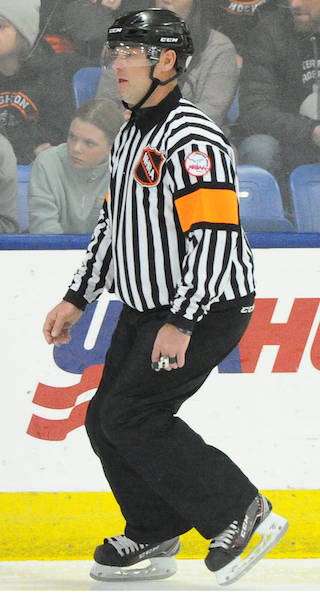 Their games lined up on just a few occasions in the NHL, and the two lobbied hard to have McCauley work Smolinski’s 1,000th career game in his final season with the Canadiens in 2007-08. The request, sadly, was denied by the league.
Their games lined up on just a few occasions in the NHL, and the two lobbied hard to have McCauley work Smolinski’s 1,000th career game in his final season with the Canadiens in 2007-08. The request, sadly, was denied by the league.
On the rare occasions when the friends did share the same ice, less than a handful by Smolinski’s count, it was McCauley who was forced to rebuff any attempts at fraternization. It’s just part of an official’s edict.
“For both of us, it was amazing; it was just great,” Smolinski said. “I’d say, ‘Hey man what’s up?’ and he says, ‘Can’t talk.’ I’m like, ‘What do you mean, we talk all the time.’ Again, he’s like, ‘Can’t talk, get away from me.’ You know, it was just business.”
McCauley then reached the 1,000-game plateau himself in 2018 and is still going strong as a regular selection for playoff duties with nine Stanley Cup Finals assignments, including last year.
So, it should have been natural for Smolinski to go to his old friend immediately for officiating pointers once he joined the ranks, right? Well, maybe not immediately.
“I talk to Wes all the time, but I actually hid it from him right out of the gate because I didn’t want to take his razzing. Eventually it got out, and he was loving it. He started sending me whistles and visors and pants,” Smolinski said, grinning. “And none of it fit, you know, because I’m older and fatter, and he’s so damn skinny. So, I still had to go out and get all new gear.”
Both Sides Now
Having been to the top of his profession, now moving to the other side of that same mountain that his friend McCauley scaled, the respect has grown for those blowing the whistle.
“The preparation for officiating is much more mental,” Smolinski said. “Way more rules oriented. You’re always trying to get away with things that you can as a player; now you have to police that.”
Smolinski has a distinct advantage.
“I know everything they’re trying to do because I’ve done it. I know where you’re going with the puck, I know what kind of breakout you’re trying to do,” Smolinski said. “I have all the instincts, now I just try to stay out of the way and not ruin their game. The most fun is watching the game develop and the ups and downs. For me to be out there and enjoy it with them, that’s the fun part.”
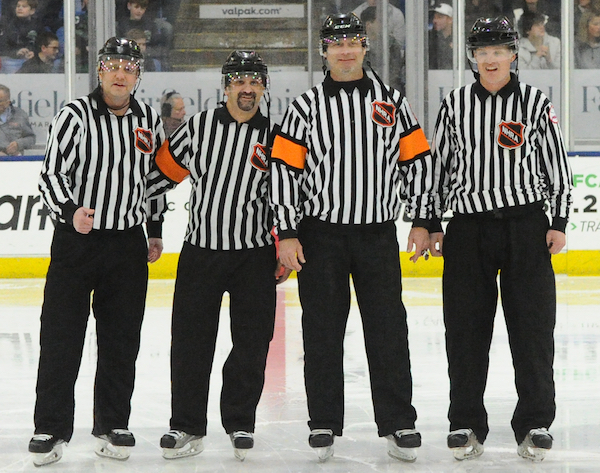 Those who have played hockey at any level have a built-in advantage should they consider the officiating avocation: the ability to skate. Unlike officiating in any other sport, skating is a prerequisite. This makes the pool limited, and almost solely composed of former players. Smolinski offers this advice.
Those who have played hockey at any level have a built-in advantage should they consider the officiating avocation: the ability to skate. Unlike officiating in any other sport, skating is a prerequisite. This makes the pool limited, and almost solely composed of former players. Smolinski offers this advice.
“I prefer sticking with high school because I think there’s more decorum, more administrative structure. Kids are playing for their schools, there’s loyalty there,” said Smolinski. “And there is more accountability. People need report to athletic directors and supervisors. Other levels can be more loosely governed, or a bit more maverick in nature. Moms and dads get involved more, coaches maybe know a little less,” said Smolinski.
He has, in fact, worked a handful of non-school games, and there’s a stark difference.
“I wanted to see what was going on, and I see it first-hand,” Smolinski said. “There are some crazy people and parents out there, and these guys are getting absolutely tortured. I’ve been tortured. There has to be a level of respect for what officials do. I think schools can rein that in a little more. All the guys I’ve met give up a lot of time and work hard because they love to do it and love the game.”
All sports need an assist from school administration and from those who once played the games to keep the officials recruitment moving in the right direction. People like Smolinski can help.
“He clearly doesn’t need to do this, and that’s what makes it so fantastic,” DiCristofaro said. “We need more people who have played – at any level – to do what he’s done and stay in the game as officials.”
Smolinski continues to promote the game in other ways as well. Currently, he is involved in the NHL’s Learn To Play initiative, which aims to inspire youth and welcome more families into the hockey community.
“We work hand-in-hand with the NHL Players Association for player development and industry growth,” Smolinski said. “Ages 5 to 9 are introduced to hockey, get head-to-toe gear and instruction, and meet some former players.”
The idea is to have fun first, which can translate into years and maybe even a lifetime in the sport. It’s a lifetime that has given Smolinski so much and continues to do so as he watches it unfold for others from his new vantage point.
PHOTOS (Top) MHSAA official Bryan Smolinski signals during Friday's Division 1 Semifinal between Brighton and Hartland. (2) Smolinski, a retired NHL standout, communicates with the Bulldogs' bench. (3) Smolinski keeps watch during game play. (4) Smolinski, third from left, with his crew: Michael Andrews, Kevin May and Thomas Robbins.

